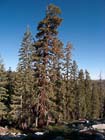
A mature tree in Yosemite National Park [C.J. Earle, 2008.07.01].

Drawing of Abies × shastensis by Matt Strieby [2016].
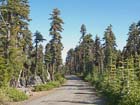
Nearly pure stand of mature Abies × shastensis along the ridgeline of Blake Mountain in northwest California [C.J. Earle, 2012.07.05].
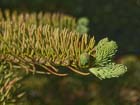
Sun foliage from one of the Blake Mountain trees shown above. The discolored needles reflect attack by a defoliating insect (unidentified). Buds have broken and current year's shoots are beginning to grow [C.J. Earle, 2012.07.05].

Upper surface of transitional sun/shade foliage from a tree of var. critchfieldii. Here again there has been attack by a defoliating insect. The blue-green needles document the previous season's growth, and the decurrent leaf bases and rows of stomata are visible. The pale green foliage reflects the initiation of growth from one terminal and two lateral buds [C.J. Earle, 2005.07.23].

Lower surface of the twig shown above [C.J. Earle, 2005.07.23].
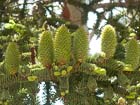
Developing cones and shoots on a tree of var. critchfieldii. Alta Peak trail, Sequoia National Park [C.J. Earle, 2008.07.02].
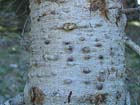
Bark of a tree 16 cm diameter. Timber Gap, Sequoia National Park [C.J. Earle, 2005.07.23].
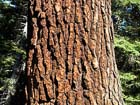
Bark of a tree 130 cm diameter. Such sizes are not uncommon in subalpine closed-canopy forest. Timber Gap, Sequoia National Park [C.J. Earle, 2005.07.23].
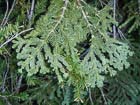
Abies × shastensis shade foliage, set against foliage of Taxus brevifolia. These branches display at least 10 years of growth. Ell Lake in the Trinity Alps of California [C.J. Earle, 2012.07.04].

Abies magnifica
A. Murray 1863
Common names
California red fir, silvertip fir (Peattie 1950), Shasta red fir (Hunt 1993).
Taxonomic notes
There is a broad zone of introgressive hybridization between Abies magnifica and A. procera that includes the southern Cascades, the Klamath Mountains, and associated coastal ranges of southwestern Oregon and Coastal California. Trees in this zone display characters intermediate between the two species; the most conspicuous such character is a transition from exserted bracts (procera) to included bracts (magnifica) in the mature female cones. These intermediate trees have been described as A. magnifica var. shastensis Lemmon (1890), a name now in wide use, but are more appropriately called Abies × shastensis Lemmon. Recognition of the hybrid origin of this taxon was long disputed, but with the morphological evidence compiled by Liu (1971) and the monoterpene evidence of Zavarin et al. (1978) now supplemented by the analysis of chloroplast haplotypes by Oline (2008), there is no longer room for reasonable doubt.
There is one variety, A. magnifica var. critchfieldii Lanner (2010), native to the southern Sierra Nevada. Neither the monoterpene studies of Zavarin et al. (1978) nor the chloroplast haplotype study of Oline (2008) differentiated this variety, and its definition is based only on characters of the female cone (overall size and exsertion of bracts).
Description
Trees to 77 m tall and 295 cm dbh with narrowly conical crowns that become cylindrical and irregular with age. Bark first smooth, thin, gray, with resin blisters; with age thickening, turning red-brown, and becoming deeply furrowed between broad ridges. Twigs opposite to whorled, light yellow to tan, with reddish pubescence. Buds hidden among leaves or exposed, dark brown, ovoid, small, not resinous or with resin drop near tip, tip rounded; basal bud scales short, broad, equilaterally triangular, densely pubescent, not resinous, margins entire to crenate, apex sharp-pointed. Leaves dark blue-green, but the new growth silvery-glaucous (hence the common name "silvertip" fir), 6-40×2 mm, spirally inserted but appearing 2-ranked in shade foliage, the basal portion often appressed to twig for 2-3 mm (best seen on lower surface of twig); cross section flat on shade foliage or quadrangular on sun foliage, with or without weak groove adaxially toward leaf base; odor camphorlike; lower surface with 2 glaucous bands, each band with 4-5 stomatal rows; upper surface blue-green to silvery blue, with single glaucous band that may divide into 2 toward leaf base, band with (8)10(13) stomatal rows at midleaf; tip rounded to pointed; resin canals 2, small, near margins and lower epidermal layer; leaf retention to at least 12 years. The shortest needles surround terminal buds at their base and remain to mark annual growth increments. Pollen cones at pollination purple or reddish brown. Seed cones oblong-cylindric, 14-23×6-9 cm in the type variety but 9-17×3-9 cm in var. critchfieldii, purple turning brown at maturity, sessile, apex round; scales ca. 3 × 4 cm, pubescent; bracts included (in the type variety) or exserted (var. critchfieldii). Seeds 15×6 mm, body dark reddish brown; wing about as long as body, pale reddish-tan; cotyledons 7-8. 2n=24 (Hunt 1993, Lanner 2010).
Hunt (1993) discriminates A. procera from A. magnifica (type variety) according to this key:
| | |
| Basal bud scales pubescent throughout; seed cones 15-20 cm, bracts included; adaxial surface of leaves usually without longitudinal groove. | A. magnifica |
| Basal bud scales pubescent centrally, glabrous at margins; seed cones 10-15 cm, bracts exserted; adaxial surface of leaves usually with longitudinal groove. | A. procera |
| | |
It's a lot less explicit, but my favorite description of this tree was provided by John Muir (1894): "Happy the man with the freedom and the love to climb one of these superb trees in full flower and fruit. How admirable the forest-work of Nature is then seen to be, as one makes his way up through the midst of the broad, fronded branches, all arranged in exquisite order around the trunk, like the whorled leaves of lilies, and each branch and branchlet about as strictly pinnate as the most symmetrical fern-frond. The staminate cones are seen growing straight downward from the under side of the young branches in lavish profusion, making fine purple clusters amid the grayish-green foliage. On the topmost branches the fertile cones are set firmly on end like small casks. They are about six inches long, three wide, covered with a fine gray down, and streaked with crystal balsam that seems to have been poured upon each cone from above."
Distribution and Ecology
USA: Oregon, California and Nevada at 1400-2700 m in mixed conifer forests (Hunt 1993). The zone of hybridization extends north from about Mount Lassen in California, and the boundary is somewhat more northerly on the east (dry) side of the species' range, than on the coastal side. Var. critchfieldii predominates south of the Kings River in California (Lanner 2010), but the nature of the boundary between the varieties (whether sharp or gradational) has not yet been studied. See also Thompson et al. (1999). Hardy to Zone 5 (cold hardiness limit between -28.8°C and -23.3°C) (Bannister and Neuner 2001).
Distribution of Abies magnifica (red), Abies × shastensis (orange), and A. procera (green). Data from USGS (1999).
Remarkable Specimens
The largest known is height 52.4 m, dbh 295 cm, in Yosemite National Park, CA; also, height 76.8 m, dbh 153 cm, in Sequoia National Park, CA (Robert Van Pelt e-mail 1998.03.18). The taller tree likely represents variety critchfieldii.
For the type variety, there is an age record of 518 years without supporting information; presumably a ring count (Carder 1995). The oldest tree recorded, though, is a specimen of Abies × shastensis: tree CL2-5 in the Klamath Mountains of California had a crossdated age of 665 years. It was collected by C. Skinner, G. Everest, and T. Kastner (RMTRR 2006).
Ethnobotany
Red fir provides a general, construction-grade wood used extensively for framing and plywood. In California, it also makes up a significant portion of the premium Christmas tree market (Laacke 1990). Once (as of 2017) it has served as the U.S. Capitol Christmas tree.
Observations
Fine stands are said to occur in Sequoia and Kings Canyon National Parks (Arno and Gyer 1973). I have seen var. critchfieldii at Timber Gap and along the Alta Peak trail in Sequoia National Park, both reasonably easy to access although some hiking is required. The stand shown at right, on Blake Mountain in California, is easily accessed by road; see Kauffmann (2012), trip 24, for details.
Remarks
The epithet magnifica means "magnificent," and shastensis refers to the area around Mount Shasta in northern California. Var. critchfieldii is named for William B. Critchfield (1923-1989) "in recognition of his distinguished contribution to the genetics, systematics, biogeography and evolution of western North American conifers" (Lanner 2010). He is now most often remembered for The Distribution of Forest Trees in California and his splendid atlas, Geographic Distribution of the Pines of the World, both still useful.
Once (as of 2017) it has served as the U.S. Capitol Christmas tree.
Citations
Arno, Stephen F. and Jane Gyer. 1973. Discovering Sierra trees. Yosemite Natural History Association. 89pp.
Kauffmann, M. 2012. Conifer Country. Kneeland, CA: Backcountry Press. Available in the Bookstore.
Laacke, Robert J. 1990. Abies magnifica A. Murr. California Red Fir, pp. 71-79 in Burns and Honkala (1990).
Lanner, R. M. 2010. Abies magnifica var. critchfieldii, a new California red fir variety from the Sierra Nevada. Madroño 57(2):141-144. Available: Biodiversity Heritage Library, accessed 2021.12.18.
Lemmon, J. 1890. Variety shastensis Lemmon, the Shasta red fir. California State Board of Forestry Biennial Report 3:145.
Oline, D. K. 2008. Geographic variation in chloroplast haplotypes in the California red fir-noble fir species complex and the status of Shasta red fir. Canadian Journal of Forest Research 38:2705-2710.
Zavarin, E., W. B. Critchfield, and K. Snajberk. 1978. Geographic differentiation of monoterpenes from Abies procera and Abies magnifica. Biochemical Systematics and Ecology 6:267-278.
See also
Elwes and Henry 1906-1913 at the Biodiversity Heritage Library (Photos). This series of volumes, privately printed, provides some of the most engaging descriptions of conifers ever published. Although they only treat species cultivated in the U.K. and Ireland, and the taxonomy is a bit dated, still these accounts are thorough, treating such topics as species description, range, varieties, exceptionally old or tall specimens, remarkable trees, and cultivation. Despite being over a century old, they are generally accurate, and are illustrated with some remarkable photographs and lithographs.
Farjon, Aljos. 1990. Pinaceae: drawings and descriptions of the genera Abies, Cedrus, Pseudolarix, Keteleeria, Nothotsuga, Tsuga, Cathaya, Pseudotsuga, Larix and Picea. Königstein: Koeltz Scientific Books.
- Provides a detailed account, with illustrations.
Lanner 1983.
Lanner 1999.
FEIS database.










